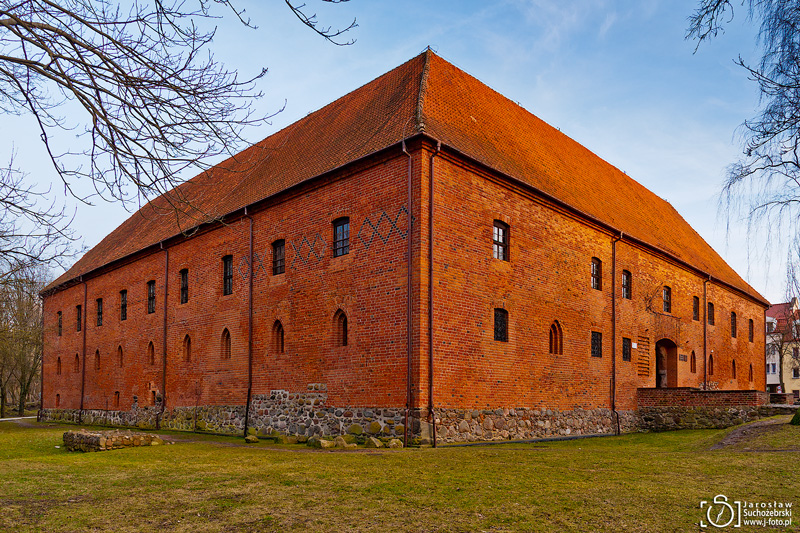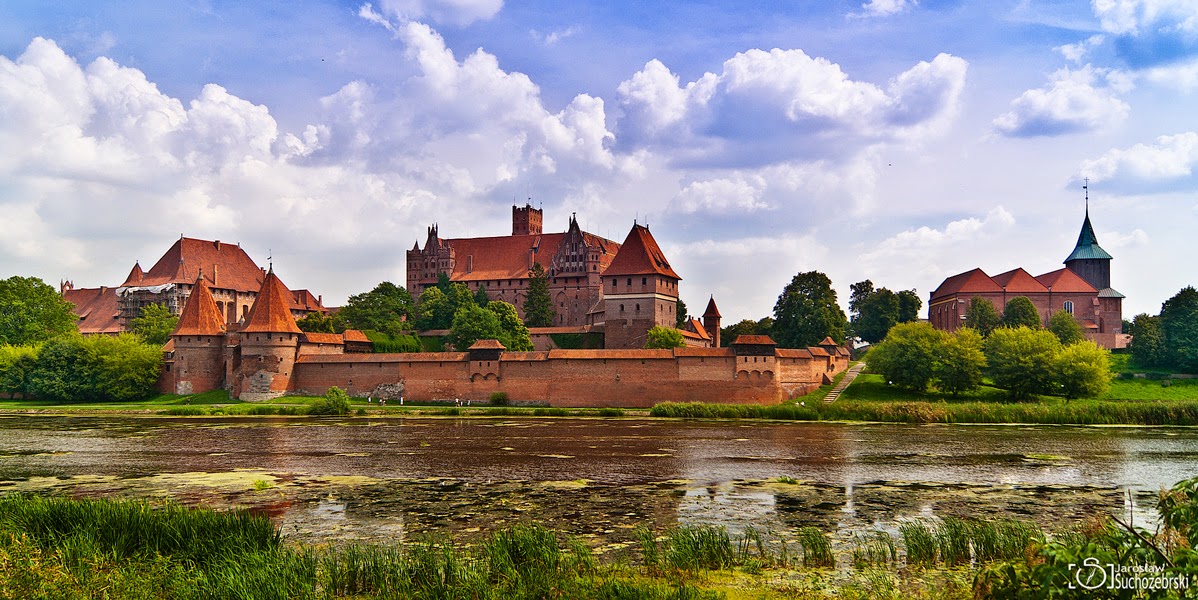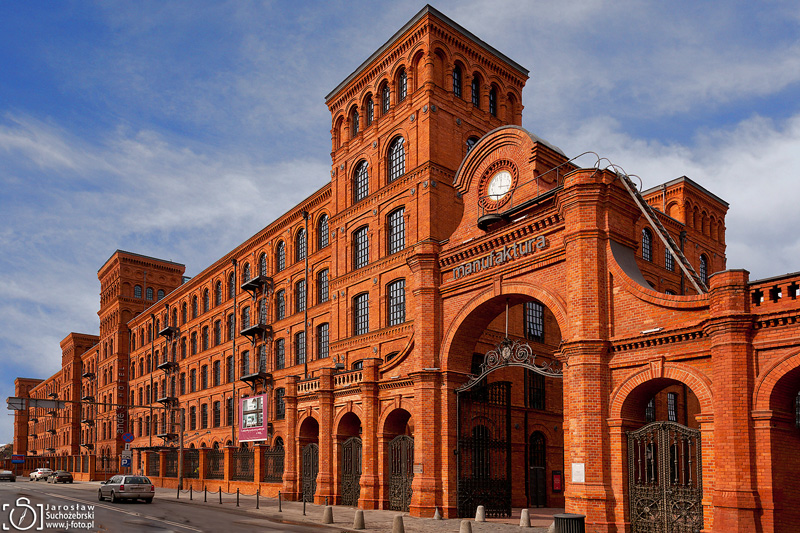Teutonic stronghold in Ostróda, Poland
Ostróda is a town in the Warmian-Masurian Voivodeship in Poland. It lies in the west of the historic Masuria region on the River Drwęca, and on the banks of Lake Drwęckie (read more: Drwęca Lake in Ostróda). The first Teutonic Order stronghold in the area comes from 1270. This was a wooden structure, located on a small island in between the waters of the Lake Drwęckie and the River Drwęca. The castle was hit by a fire during a Lithuanian raid in 1381. It had a rectangular ground plan, a court in its middle and a moat surrounding the monument. Its front wing containing the gateway was, just like two other side wings, the commander's domicile.
Soon afterwards a new brick castle was built. During the wars of the Teutonic Order, this was a strategic site. The access point from the east of the castle was by a bridge, which led to a granite gate. The castle was surrounded by the village where served means for keeping storage, brewery and a forge. Getting ready for the new war with the Kingdom of Poland, the castle was surrounded by a moat filled with water. The castle was taken by the Poles after the Battle of Grunwald - July 14, 1410. For two months, Ostróda castle remained in the hands of Duke of Masovia, Janusz Mazowiecki (read article Castle of the Dukes of Mazovia in Ciechanów) but in September 1410 the castle returned to the Teutonic Knights.
The castle became greatly diminished in the next centuries. In the great fire of Ostróda in 1788, the great explosion of gunpowder damaged the castle. The castle was rebuilt, but it did not regain its previous shape.
From 21st February to 1st April 1807 the castle hosted the French emperor, Napoleon Bonaparte. There are a number of art objects documenting the event, e.g. the painting by the Marie Nicolas Ponce-Camus 'Napoleon promises his grace to Ostróda burgers. March 1807' and silver medal "Napoleon a Osterode", made by the French graver Bertrand Andrieu.
The castle was restored in the 19th century and was a seat for the local administration office and court of justice. During World War II the castle was burned down by the Soviet Army and remained in the state of preserved ruin for nearly thirty years. The reconstruction of the castle was commenced in 1974 and continued until the 1990s. Currently, the castle houses a gallery, library and a museum.
You might also like other articles about most beautiful Polish castles, palaces and fortresses (click to read)
* * *
This post is linked at:
Through My Lens, Our Word Tuesday, Travel Tuesday, Other Wordless Wednesday, Wordless Wednesday, Wednesday Around The Word, Outdoor Wednesday, Skywatch Friday, Weekend Travel Inspiration































WOW! Funnily enough we just got a new picturebook at my library that's all about how bricks are made, and immediately thought about it when I saw your photos - that is a lot of red bricks!!
ReplyDeleteI wonder what the castle would have originally looked like? It is quite striking today with its red brickwork but it looks less like a castle and more like a large farm building. What a fascinating history. Thanks for linking up with #MondayEscapes
ReplyDeleteThis old building certainly has an interesting past!
ReplyDeleteVery impressive structure. I really enjoy your posts!
ReplyDeleteWhat a handsome building. I really like bricks.
ReplyDeleteRemarkable building!
ReplyDeleteWow, this one has been through a lot. I'm so glad that it hasn't been ignored or razed, even if it's not the original shape. Thanks for sharing this piece of history with us :)
ReplyDeletePięknie wygląda i ciekawy ze względu na swoją indywidualność wśród budowli krzyżackich. Pozdrawiamy
ReplyDeleteTruly Awesome. Thanks a lot for the post.
ReplyDeleteLove the colorful photographs of this building, and the history you share. It's been through a lot...oh to be a fly on the wall with all the memories contained there in. :) Enjoyed reading.
ReplyDeleteAmazing color! I love brick houses and this one is extra special because of it's amazing greenery around it!
ReplyDeleteSteve
Gorgeous red brick buildings for Ruby and great photography ~ thanks,
ReplyDeleteWishing you a Happy Week ~ ^_^
At least, there is something left of this castle. I think it is better that way since it helps to draw visitors and in that way the history of the place and area is shared. Seems more difficult to attract people to an empty area. #WordlessWednesday
ReplyDeleteThis building looks impenetrable!
ReplyDeletehttps://readerbuzz.blogspot.com/2017/04/annie-shares-flower.html
What a marvelous old structure.
ReplyDeleteToo bad the building was damaged by fire in 1788 and needed to be rebuilt. What a marvelous red looking building.
ReplyDeleteGreat post on an impressive looking historic building. Thank you for sharing!
ReplyDeleteThat red brick is gorgeous! And what a story for it as well.
ReplyDeleteThose dates (1400s) are just mind-boggling. I love the red color, and just think of all the history that's taken place in this castle through hundreds of years.
ReplyDeletelooks enormous
ReplyDeleteMagnificent structure.
ReplyDeleteWonderful structure, beautifully captured!
ReplyDeleteNigdy nie byłam.., ciekawie wygląda, pozdrawiam
ReplyDeleteImpressive brickwork, dwarfing the doors.
ReplyDeleteThat castle has a marvelous history, both ancient and recent.
ReplyDeleteA solid-looking structure!
ReplyDeletejanet
Napolean - I forgot that he spent time in Poland:) Love your next-to-last capture with all the arches! A noteworthy subject! Hope to see you back in a few days for "All Seasons!"
ReplyDeleteRed bricks! Look so fascinating and indeed grab people's attention!
ReplyDeleteIt looks like a very formidable building!
ReplyDeleteInteresting structure
ReplyDeleteI love the history of this beautiful building!! Thanks for sharing.
ReplyDeleteA very imposing structure, but has seen even better days!
ReplyDeleteWonderful picture! Have to visit it once :) Thanks!
ReplyDeleteThe castle looks formidable yet rather plain. I wonder what it looked like originally before all the damage and reconstructions.
ReplyDeleteThanks for sharing! Some day when I return to Poland I am going to have a long list of places to visit!
ReplyDeleteThat's an imposing building - very impressive.
ReplyDeleteBut there was a moat! And it's a pretty solid looking building, how did the Polish take it in 1410? I can't even imagine that time.
ReplyDeleteIn 1410 there was a war between Kingdom of Poland and Teutonic State. The biggest event during this war was the Battle of Grunwald on 15 July 1410. The alliance of the Kingdom of Poland and the Grand Duchy of Lithuania, decisively defeated the German–Prussian Teutonic Knights. The battle was one of the largest in Medieval Europe and is regarded as the most important victory in the histories of Poland, Belarus and Lithuania.
DeleteOh that red brick is beautiful! Thanks for linking up with #TheWeeklyPostcard! (www.caliglobetrotter.com)
ReplyDeleteSuch gorgeous old buildings! Thanks for sharing. Hope you have a blessed Easter SONday!
ReplyDeleteIt does look imposing, and what a history. Thanks for linking up this week! #wkendtravelinspiration
ReplyDeleteBardzo lubie taka architekture. Ceglane budynki maja niepowtarzalny klimat :)
ReplyDeleteLovely structures in red! Great to see it's holding on well up until now..
ReplyDeleteThe castle really underscores the uncertain future a castle faces. Built, burnt, built again - what a history. Thanks for sharing on #TheWeeklyPostcard!
ReplyDeleteexcellent.
ReplyDeleteYour pictures of this building are magnificent! What an interesting story!
ReplyDeleteFantastic photos of a beautiful red brick building. It's great that they have repurposed it so people can continue to enjoy it! #Wkendtravelinspiration
ReplyDelete